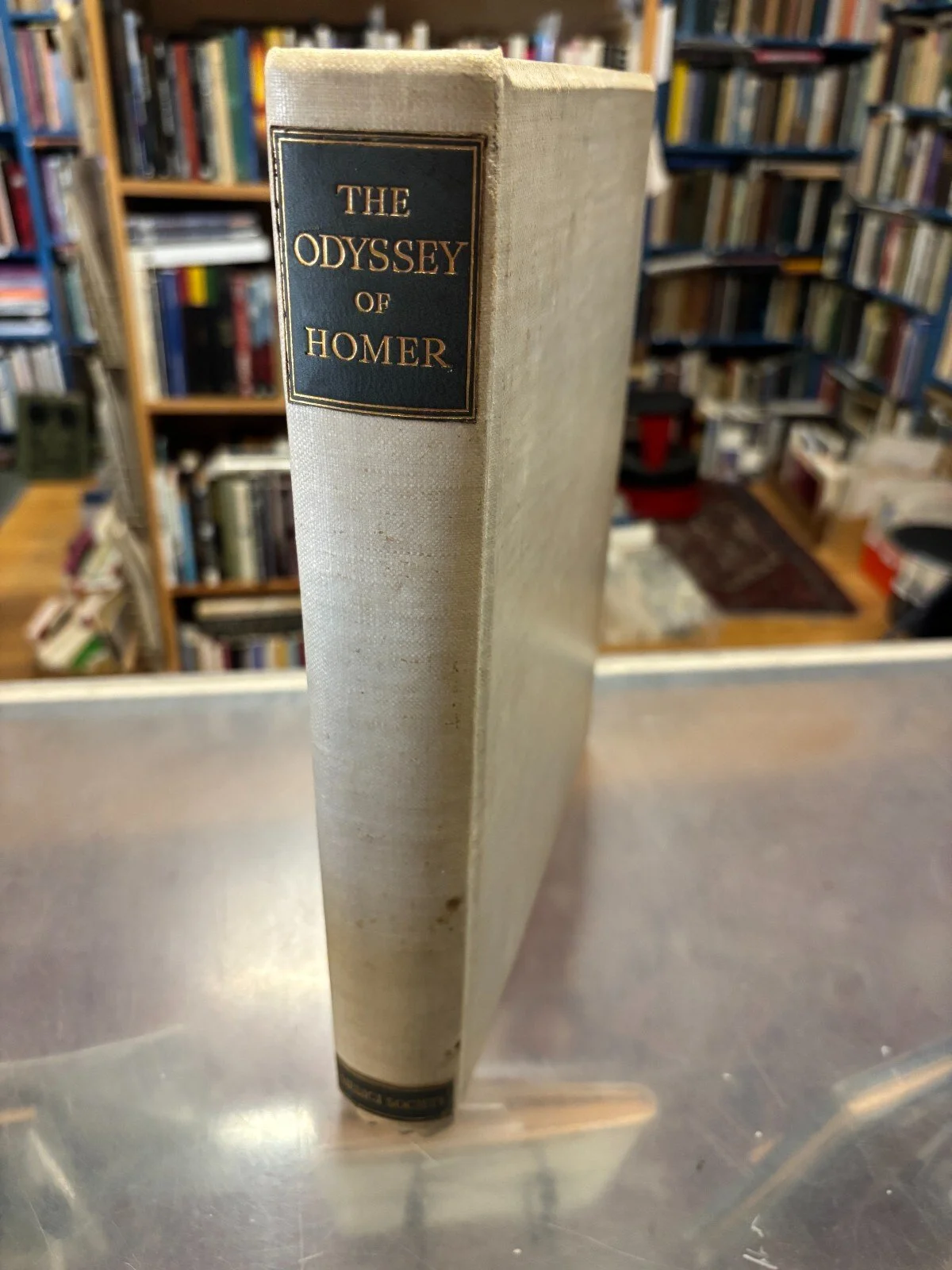 Image 1 of 10
Image 1 of 10

 Image 2 of 10
Image 2 of 10

 Image 3 of 10
Image 3 of 10

 Image 4 of 10
Image 4 of 10

 Image 5 of 10
Image 5 of 10

 Image 6 of 10
Image 6 of 10

 Image 7 of 10
Image 7 of 10

 Image 8 of 10
Image 8 of 10

 Image 9 of 10
Image 9 of 10

 Image 10 of 10
Image 10 of 10











The Odyssey of Homer - 1924 Limited to 500. Andrew Lang. Medici Society.
$500.00
A substantial, impressive volume, in bevelled linen boards measuring 11.5" x 9.5". With gilt moroccan labels on the spine. With some toning and light soiling to the linen.Top Edges Gilded. Text on handmade watermarked laid English paper with deckle edges. Sharp, crisp lithographs protected by captioned tissue guards. Text printed on creamy paper, clean and attractive. A volume rich in the patina of time, in very good condition with all 20 luminous color plates present. A collector's copy No. 415/500copies. Russell Flint was born in Edinburgh on 4 April 1880 and was educated at Daniel Stewart's College and then Edinburgh Institution.[2] From 1894 to 1900 Flint was apprenticed as a lithographic draughtsman while taking classes at the Royal Institute of Art, Edinburgh.[3] From 1900 to 1902 he worked as a medical illustrator in London while studying part-time at the Heatherley School of Fine Art.[4] He furthered his art education by studying independently at the British Museum. He was an artist for The Illustrated London News from 1903 to 1907, and produced illustrations for editions of several books, including H Rider Haggard's King Solomon's Mines (1907 edition),[5] W. S. Gilbert's Savoy Operas (1909),[6] Sir Thomas Malory's Le Morte d'Arthur (1910 1911)[7] and Chaucer's The Canterbury Tales (1912).[3]Flint was one of the leading illustrators selected by Percy Bradshaw for inclusion in his The Art of the Illustrator (1917-1918) which presented a separate portfolio for each of twenty illustrators which was accompanied by a plate showing an illustration typical of Flint's work and five other plates showing the work at five earlier stages of its production.[8] Flint's coloured illustration shows one naked and one half naked young woman picking fruit on a sea shore.[9]Flint was elected president of Britain's Royal Society of Painters in Watercolours (now the Royal Watercolour Society) in 1936 to 1956, and knighted in 1947.[2]During visits to Spain, Flint was impressed by Spanish dancers, and he depicted them frequently throughout his career.[4] He enjoyed considerable commercial success but little respect from art critics, who were disturbed by a perceived crassness in his eroticized treatment of the female figure,[4] clearly borrowing inspiration from similar works by Lawrence Alma-Tadema.[10]Flint was also a published author of short stories. In 1965, a collection of his short stories were published as a limited edition of 500 titled Shadows in Arcady; for which Flint designed the graphical layout and the illustrations.[citation needed] Previously, Flint's story "The Angelus" had been published in The Times newspaper.Flint was active as an artist and a writer until his death in London on 30 December 1969. (Wikipedia) Special limited edition, this being copy No. 415 of 530 copies printed, only 500 of which were for sale.
A substantial, impressive volume, in bevelled linen boards measuring 11.5" x 9.5". With gilt moroccan labels on the spine. With some toning and light soiling to the linen.Top Edges Gilded. Text on handmade watermarked laid English paper with deckle edges. Sharp, crisp lithographs protected by captioned tissue guards. Text printed on creamy paper, clean and attractive. A volume rich in the patina of time, in very good condition with all 20 luminous color plates present. A collector's copy No. 415/500copies. Russell Flint was born in Edinburgh on 4 April 1880 and was educated at Daniel Stewart's College and then Edinburgh Institution.[2] From 1894 to 1900 Flint was apprenticed as a lithographic draughtsman while taking classes at the Royal Institute of Art, Edinburgh.[3] From 1900 to 1902 he worked as a medical illustrator in London while studying part-time at the Heatherley School of Fine Art.[4] He furthered his art education by studying independently at the British Museum. He was an artist for The Illustrated London News from 1903 to 1907, and produced illustrations for editions of several books, including H Rider Haggard's King Solomon's Mines (1907 edition),[5] W. S. Gilbert's Savoy Operas (1909),[6] Sir Thomas Malory's Le Morte d'Arthur (1910 1911)[7] and Chaucer's The Canterbury Tales (1912).[3]Flint was one of the leading illustrators selected by Percy Bradshaw for inclusion in his The Art of the Illustrator (1917-1918) which presented a separate portfolio for each of twenty illustrators which was accompanied by a plate showing an illustration typical of Flint's work and five other plates showing the work at five earlier stages of its production.[8] Flint's coloured illustration shows one naked and one half naked young woman picking fruit on a sea shore.[9]Flint was elected president of Britain's Royal Society of Painters in Watercolours (now the Royal Watercolour Society) in 1936 to 1956, and knighted in 1947.[2]During visits to Spain, Flint was impressed by Spanish dancers, and he depicted them frequently throughout his career.[4] He enjoyed considerable commercial success but little respect from art critics, who were disturbed by a perceived crassness in his eroticized treatment of the female figure,[4] clearly borrowing inspiration from similar works by Lawrence Alma-Tadema.[10]Flint was also a published author of short stories. In 1965, a collection of his short stories were published as a limited edition of 500 titled Shadows in Arcady; for which Flint designed the graphical layout and the illustrations.[citation needed] Previously, Flint's story "The Angelus" had been published in The Times newspaper.Flint was active as an artist and a writer until his death in London on 30 December 1969. (Wikipedia) Special limited edition, this being copy No. 415 of 530 copies printed, only 500 of which were for sale.
